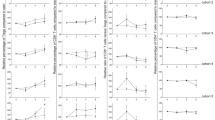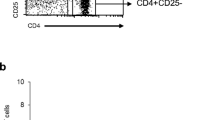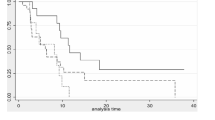Abstract
Targeted therapy with sunitinib, pazopanib or everolimus has improved treatment outcome for patients with metastatic renal cell carcinoma patients (RCC). However, despite considerable efforts in sequential or combined modalities, durable remissions are rare. Immunotherapy like cytokine therapy with interleukin-2, T cell checkpoint blockade or adoptive T cell therapies can achieve long-term benefit and even cure. This raises the question of whether combining targeted therapy with immunotherapy could also be an effective treatment option for RCC patients. Sunitinib, one of the most frequently administered therapeutics in RCC patients has been implicated in impairing T cell activation and proliferation in vitro. In this work, we addressed whether this notion holds true for expansion of tumor-infiltrating lymphocytes (TILs) in sunitinib-treated patients. We compared resected primary RCC tumor material of patients pretreated with sunitinib with resection specimen from sunitinib-naïve patients. We found improved TIL expansion from sunitinib-pretreated tumor digests. These TIL products contained more PD-1 expressing TIL, while the regulatory T cell infiltration was not altered. The improved TIL expansion was associated with reduced intratumoral myeloid-derived suppressor cell (MDSC) content. Depletion of MDSCs from sunitinib-naïve RCC tissue-digest improved TIL expansion, proving the functional relevance of the MDSC alteration by sunitinib. Our in vivo results do not support previous in vitro observations of sunitinib inhibiting T cell function, but do provide a possible rationale for the combination of sunitinib with immunotherapy.



Similar content being viewed by others
Abbreviations
- ACT:
-
Adoptive cell therapy
- CD:
-
Cluster of differentiation
- CTLA-4:
-
Cytotoxic T-lymphocyte-associated protein 4
- DCs:
-
Dendritic cells
- IFN:
-
Interferon
- IHC:
-
Immunohistochemistry
- IL:
-
Interleukin
- FACS:
-
Fluorescence-activated cell sorting
- HPF:
-
High power field
- MDSCs:
-
Myeloid-derived suppressor cells
- MFI:
-
Mean fluorescent intensity
- mRCC:
-
Metastasized renal cell carcinoma
- mTOR:
-
Mammalian target of rapamycin
- NK:
-
Natural killer
- NKT:
-
Natural killer T
- NKI:
-
The Netherlands Cancer Institute
- PD-1:
-
Programed death receptor-1
- PD-L1:
-
Programed death receptor ligand-1
- pTx:
-
Pre-treatment
- RCC:
-
Renal cell carcinoma
- TcCB:
-
T cell checkpoint blockade
- TILs:
-
Tumor-infiltrating lymphocytes
- TKIs:
-
Tyrosine kinase inhibitors
- Treg:
-
Regulatory T cells
- VEGF-R:
-
Vascular endothelial growth factor receptor
References
Golimbu M, Joshi P, Sperber A, Tessler A, Al-Askari S, Morales P (1986) Renal cell carcinoma: survival and prognostic factors. Urology 27:291–301
Coppin C, Le L, Porzsolt F, Wilt T (2008) Targeted therapy for advanced renal cell carcinoma. Cochrane Database Syst Rev CD006017. doi:10.1002/14651858.CD006017.pub2
Albiges L, Choueiri T, Escudier B et al (2014) A systematic review of sequencing and combinations of systemic therapy in metastatic renal cancer. Eur Urol 67:100–110. doi:10.1016/j.eururo.2014.04.006
Klapper JA, Downey SG, Smith FO et al (2008) High-dose interleukin-2 for the treatment of metastatic renal cell carcinoma: a retrospective analysis of response and survival in patients treated in the surgery branch at the National Cancer Institute between 1986 and 2006. Cancer 113:293–301. doi:10.1002/cncr.23552
De Mulder PH, Oosterhof G, Bouffioux C, van Oosterom AT, Vermeylen K, Sylvester R (1995) EORTC (30885) randomised phase III study with recombinant interferon alpha and recombinant interferon alpha and gamma in patients with advanced renal cell carcinoma. The EORTC Genitourinary Group. Br J Cancer 71:371–375
Blank CU (2014) The perspective of immunotherapy: new molecules and new mechanisms of action in immune modulation. Curr Opin Oncol 26:204–214. doi:10.1097/CCO.0000000000000054
Motzer RJ, Rini BI, McDermott DF et al (2014) Nivolumab for metastatic renal cell carcinoma: results of a randomized phase II trial. J Clin Oncol. doi:10.1200/JCO.2014.59.0703
Rosenberg SA, Dudley ME (2009) Adoptive cell therapy for the treatment of patients with metastatic melanoma. Curr Opin Immunol 21:233–240. doi:10.1016/j.coi.2009.03.002
Alexandrov LB, Nik-Zainal S, Wedge DC, Campbell PJ, Stratton MR (2013) Deciphering signatures of mutational processes operative in human cancer. Cell Rep 3:246–259. doi:10.1016/j.celrep.2012.12.008
Heemskerk B, Kvistborg P, Schumacher TN (2013) The cancer antigenome. EMBO J 32:194–203. doi:10.1038/emboj.2012.333
van Rooij N, van Buuren MM, Philips D et al (2013) Tumor exome analysis reveals neoantigen-specific T-cell reactivity in an ipilimumab-responsive melanoma. J Clin Oncol 31:e439–e442. doi:10.1200/JCO.2012.47.7521
Shrimali RK, Yu Z, Theoret MR, Chinnasamy D, Restifo NP, Rosenberg SA (2010) Antiangiogenic agents can increase lymphocyte infiltration into tumor and enhance the effectiveness of adoptive immunotherapy of cancer. Cancer Res 70:6171–6180. doi:10.1158/0008-5472.CAN-10-0153
Ko JS, Rayman P, Ireland J, Swaidani S, Li G, Bunting KD, Rini B, Finke JH, Cohen PA (2010) Direct and differential suppression of myeloid-derived suppressor cell subsets by sunitinib is compartmentally constrained. Cancer Res 70:3526–3536. doi:10.1158/0008-5472.CAN-09-3278
Ozao-Choy J, Ma G, Kao J et al (2009) The novel role of tyrosine kinase inhibitor in the reversal of immune suppression and modulation of tumor microenvironment for immune-based cancer therapies. Cancer Res 69:2514–2522. doi:10.1158/0008-5472.CAN-08-4709
Farsaci B, Higgins JP, Hodge JW (2012) Consequence of dose scheduling of sunitinib on host immune response elements and vaccine combination therapy. Int J Cancer 130:1948–1959. doi:10.1002/ijc.26219
Bose A, Lowe DB, Rao A, Storkus WJ (2012) Combined vaccine + axitinib therapy yields superior antitumor efficacy in a murine melanoma model. Melanoma Res 22:236–243. doi:10.1097/CMR.0b013e3283538293
Gu Y, Zhao W, Meng F, Qu B, Zhu X, Sun Y, Shu Y, Xu Q (2010) Sunitinib impairs the proliferation and function of human peripheral T cell and prevents T-cell-mediated immune response in mice. Clin Immunol 135:55–62. doi:10.1016/j.clim.2009.11.013
Alfaro C, Suarez N, Gonzalez A et al (2009) Influence of bevacizumab, sunitinib and sorafenib as single agents or in combination on the inhibitory effects of VEGF on human dendritic cell differentiation from monocytes. Br J Cancer 100:1111–1119. doi:10.1038/sj.bjc.6604965
van Cruijsen H, van der Veldt AA, Vroling L et al (2008) Sunitinib-induced myeloid lineage redistribution in renal cell cancer patients: CD1c+ dendritic cell frequency predicts progression-free survival. Clin Cancer Res 14:5884–5892. doi:10.1158/1078-0432.CCR-08-0656
Ko JS, Zea AH, Rini BI et al (2009) Sunitinib mediates reversal of myeloid-derived suppressor cell accumulation in renal cell carcinoma patients. Clin Cancer Res 15:2148–2157. doi:10.1200/JCO.2012.47.7521
Taube JM, Anders RA, Young GD et al (2012) Colocalization of inflammatory response with B7-h1 expression in human melanocytic lesions supports an adaptive resistance mechanism of immune escape. Sci Transl Med 4:127ra37. doi:10.1126/scitranslmed.3003689
Carter L, Fouser LA, Jussif J et al (2002) PD-1:PD-L inhibitory pathway affects both CD4(+) and CD8(+) T cells and is overcome by IL-2. Eur J Immunol 32:634–643
Najjar YG, Finke JH (2013) Clinical perspectives on targeting of myeloid derived suppressor cells in the treatment of cancer. Front Oncol 3:49. doi:10.3389/fonc.2013.00049
Finke J, Ko J, Rini B, Rayman P, Ireland J, Cohen P (2011) MDSC as a mechanism of tumor escape from sunitinib mediated anti-angiogenic therapy. Int Immunopharmacol 11:856–861. doi:10.1016/j.intimp.2011.01.030
Motzer RJ, Hutson TE, Tomczak P et al (2009) Overall survival and updated results for sunitinib compared with interferon alfa in patients with metastatic renal cell carcinoma. J Clin Oncol 27:3584–3590. doi:10.1200/JCO.2008.20.1293
Topalian SL, Hodi FS, Brahmer JR et al (2012) Safety, activity, and immune correlates of anti-PD-1 antibody in cancer. N Engl J Med 366:2443–2454. doi:10.1056/NEJMoa1200690
Panka DJ, Liu Q, Geissler AK, Mier JW (2013) Effects of HDM2 antagonism on sunitinib resistance, p53 activation, SDF-1 induction, and tumor infiltration by CD11b+/Gr-1+ myeloid derived suppressor cells. Mol Cancer 12:17. doi:10.1186/1476-4598-12-17
Finke JH, Rini B, Ireland J et al (2008) Sunitinib reverses type-1 immune suppression and decreases T-regulatory cells in renal cell carcinoma patients. Clin Cancer Res 14:6674–6682. doi:10.1158/1078-0432.CCR-07-5212
Florcken A, Takvorian A, Van Lessen A, Singh A, Hopfenmuller W, Dorken B, Pezzutto A, Westermann J (2012) Sorafenib, but not sunitinib, induces regulatory T cells in the peripheral blood of patients with metastatic renal cell carcinoma. Anticancer Drugs 23:298–302. doi:10.1097/CAD.0b013e32834ee2b1
Bose A, Taylor JL, Alber S et al (2011) Sunitinib facilitates the activation and recruitment of therapeutic anti-tumor immunity in concert with specific vaccination. Int J Cancer 129:2158–2170. doi:10.1002/ijc.25863
Farsaci B, Donahue RN, Coplin MA, Grenga I, Lepone LM, Molinolo AA, Hodge JW (2014) Immune consequences of decreasing tumor vasculature with antiangiogenic tyrosine kinase inhibitors in combination with therapeutic vaccines. Cancer Immunol Res 2:1090–1102. doi:10.1158/2326-6066.CIR-14-0076
Linnemann C, Mezzadra R, Schumacher TN (2014) TCR repertoires of intratumoral T-cell subsets. Immunol Rev 257:72–82. doi:10.1111/imr.12140
Kvistborg P, Shu CJ, Heemskerk B et al (2012) TIL therapy broadens the tumor-reactive CD8(+) T cell compartment in melanoma patients. Oncoimmunology 1:409–418
Kujawski M, Kortylewski M, Lee H, Herrmann A, Kay H, Yu H (2008) Stat3 mediates myeloid cell-dependent tumor angiogenesis in mice. J Clin Invest 118:3367–3377. doi:10.1172/JCI35213
Blank C, Kuball J, Voelkl S et al (2006) Blockade of PD-L1 (B7-H1) augments human tumor-specific T cell responses in vitro. Int J Cancer 119:317–327. doi:10.1002/ijc.21775
Thompson RH, Kuntz SM, Leibovich BC et al (2006) Tumor B7-H1 is associated with poor prognosis in renal cell carcinoma patients with long-term follow-up. Cancer Res 66:3381–3385. doi:10.1158/0008-5472.CAN-05-4303
Noman MZ, Desantis G, Janji B, Hasmim M, Karray S, Dessen P, Bronte V, Chouaib S (2014) PD-L1 is a novel direct target of HIF-1alpha, and its blockade under hypoxia enhanced MDSC-mediated T cell activation. J Exp Med 211:781–790. doi:10.1084/jem.20131916
Acknowledgments
This work was funded by an in house grant (start-up funding) of the Netherlands Cancer Institute.
Conflict of interest
The authors declare that they have the following conflicts of interest in context of this manuscript: Axel Bex and John Haanen are principal investigators of the SURTIME study that is financed by an educational grant from Pfizer to the European Organisation EORTC. Axel Bex and John Haanen received compensation for advisory roles from Pfizer. All other authors declare that they have no conflict of interest.
Author information
Authors and Affiliations
Corresponding author
Electronic supplementary material
Below is the link to the electronic supplementary material.
Rights and permissions
About this article
Cite this article
Guislain, A., Gadiot, J., Kaiser, A. et al. Sunitinib pretreatment improves tumor-infiltrating lymphocyte expansion by reduction in intratumoral content of myeloid-derived suppressor cells in human renal cell carcinoma. Cancer Immunol Immunother 64, 1241–1250 (2015). https://doi.org/10.1007/s00262-015-1735-z
Received:
Accepted:
Published:
Issue Date:
DOI: https://doi.org/10.1007/s00262-015-1735-z




